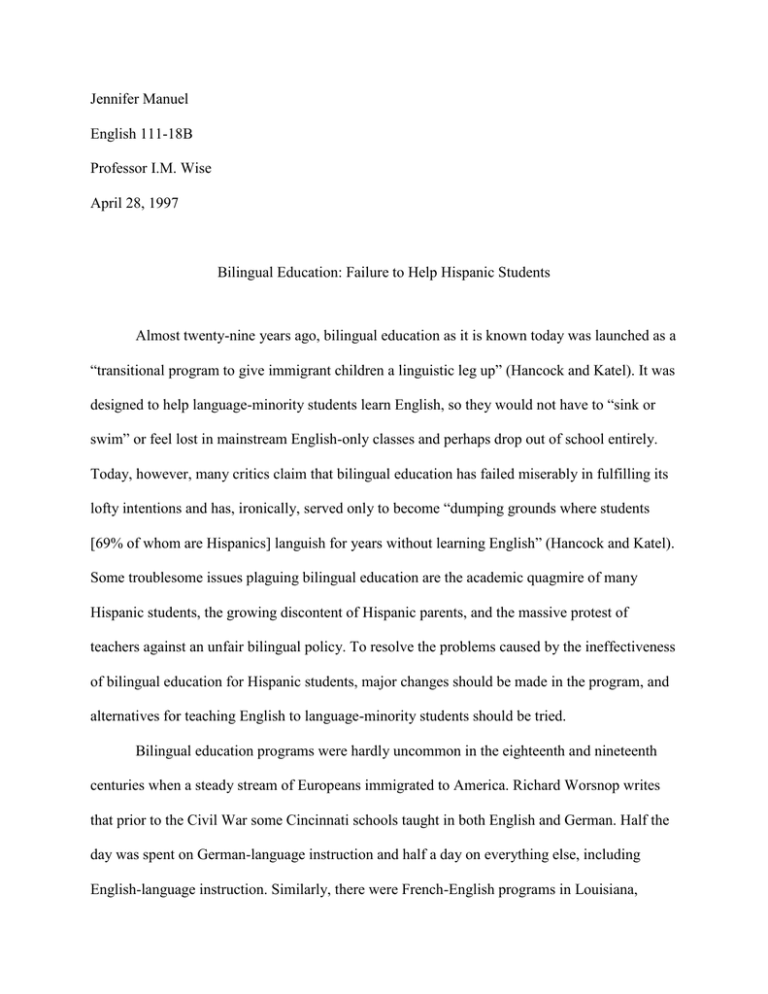Jennifer Manuel English 111-18B Professor I.M. Wise April 28, 1997
advertisement

Jennifer Manuel English 111-18B Professor I.M. Wise April 28, 1997 Bilingual Education: Failure to Help Hispanic Students Almost twenty-nine years ago, bilingual education as it is known today was launched as a “transitional program to give immigrant children a linguistic leg up” (Hancock and Katel). It was designed to help language-minority students learn English, so they would not have to “sink or swim” or feel lost in mainstream English-only classes and perhaps drop out of school entirely. Today, however, many critics claim that bilingual education has failed miserably in fulfilling its lofty intentions and has, ironically, served only to become “dumping grounds where students [69% of whom are Hispanics] languish for years without learning English” (Hancock and Katel). Some troublesome issues plaguing bilingual education are the academic quagmire of many Hispanic students, the growing discontent of Hispanic parents, and the massive protest of teachers against an unfair bilingual policy. To resolve the problems caused by the ineffectiveness of bilingual education for Hispanic students, major changes should be made in the program, and alternatives for teaching English to language-minority students should be tried. Bilingual education programs were hardly uncommon in the eighteenth and nineteenth centuries when a steady stream of Europeans immigrated to America. Richard Worsnop writes that prior to the Civil War some Cincinnati schools taught in both English and German. Half the day was spent on German-language instruction and half a day on everything else, including English-language instruction. Similarly, there were French-English programs in Louisiana, Spanish- English programs in the Territory of New Mexico, and assorted Norwegian, Czech, Italian, Polish, and Dutch programs (704). However, he mentions that in the late 1900's, antiChristianism and xenophobia put a damper on these early bilingual education programs, causing them to be dismantled and making English the mandatory medium of instruction for teaching newcomers. According to Worsnop, it was not until much later, in the 1950's, that bilingual education, sparked by the arrival of Cuban refugees in south Florida, was resurrected. He states that the first experimental bilingual education programs were spearheaded by Dade County (Miami) to help arriving children adapt to their new environment, and soon other communities followed suit. “The widespread support for bilingual education,” he says, “helped advocates persuade lawmakers to fund bilingual programs during Congressional hearings in 1967” (707). Hence, in 1968, the Bilingual Education Act (Title VII of the Elementary and Secondary Education Act), which encourages local school districts to establish bilingual programs by using grants provided by law, was enacted (699). Paul Long, author of The English Language Debate: One Nation One Language, states, “By 1973, the federal budget for bilingual education had grown to 45 million dollars, and it supported programs in twenty-six different languages” (61). Today, bilingual education obtains $10 billion annually in funding and accommodates a vast aggregate of immigrant groups, the largest being Hispanics. Several approaches used to teach English to language-minority students are designed to counteract the “sink or swim” dilemma1 experienced by the European immigrants following the abolition of early bilingual education programs in the late 1900's. Some of the more popular programs today, which are more vernacular oriented than English-based, are the Transitional Bilingual Education (TBE), the Developmental Bilingual Education (DBE), and the Two-way Bilingual Education. The TBE program “teaches students subject matter in their native language as needed for them to keep up with their English-speaking peers while enrolling them in special classes that teach them English as A Second Language (ESL)” (Donegan 54). The DBE program, on the other hand, is “designed to increase the student's native-language skills by teaching the student in his or her native language plus English at least through the sixth grade” (54). The two-way bilingual education is somehow the most advanced developmental approach among the rest because it allows both native and non-native English speakers to study in the same classroom, in which English is taught for half a day and the other language taught in the other half (54). Remarkably enough, these bilingual programs get the bigger slice of the funding pie. According to Susan Headden, “Seventy-five percent of federal money . . . goes toward classes taught in students’ native tongues; only 25 percent supports programs rooted in English. This makes bilingual education the de facto law of the land.” Despite its noble intentions, bilingual education is facing mounting oppositions from a growing number of diverse detractors who incessantly lambaste the federally-funded program and its efficacy, calling it a "bilingual sand trap" or even more harshly, a “bilingual prison” for Hispanic students. Headden declares, “Hispanics have been the largest casualty of the failed [bilingual education] program.” Moreover, in “Children in Prison,” Diane Ravitch illustrates how most Hispanic students are placed unfairly in bilingual classes: In New York City, a 1974 consent decree required that every child with a Spanish surname and every child from a home in which anyone speaks a non-English language must take an English proficiency test. Any child who scores in the bottom 40% is automatically placed in a bilingual class, even if English is the primary language spoken at home and even if the child knows more English than Spanish. In short, the system is programmed to fill the bilingual classrooms. (94) Hispanic students also stay in bilingual education for far too long. State law requires that children receive no more than three years of bilingual education. Asian and Russian children move quickly into English classes, but most Hispanics are retained in bilingual programs for several years. One mother even complains that her daughter has been in “a 'transitional' bilingual program for nine years” (Ravitch 94). Rosalie Porter comments, “The longer students remain in linguistically segregated bilingual programs, the less successful they are in school work” (13A). For instance, a 1994 New York study shows that children in bilingual classes are slower to join English-language curriculum than youngsters who learned English in ESL programs (Ravitch 94). Worse, the drop-out rate for Latino students “remains the highest in the country despite 29 years of investment in bilingual programs”(Porter 13A). As a result of these problems, Hispanic parents are getting involved—they want their children out of the so-called “bilingual prison.” Donegan reports that the Bushwick Parents Organization, which represents one hundred fifty Brooklyn, New York, families, has sued the state education commissioner for allegedly allowing tens of thousands of students to be held back for well over the normal three-year stay in bilingual classes (64). Additionally, “In Los Angeles, over 100 Latino parents picketed their local school for almost two weeks to protest the lack of English instruction” (Amselle). Donegan concludes, “Hispanic parents believe bilingual education is not serving its purpose of teaching their children the language, English, which is perhaps their most important 'ticket to the American dream’” (64). Besides the parents, teachers have also jumped into the anti-bilingual education bandwagon. In Westminster, California, where at least one school has a non-English speaking student population of 78 percent, teachers were informed by their administrators that they could be transferred if they refused to take classes to learn Spanish or Vietnamese. The new school board president, however, asserted that it was unconstitutional to force American citizens to learn a foreign language in order to keep their job. The board has said it will phase out bilingual classes (Donegan 64). Jorge Amselle in his National Review article says that the Teachers Association also has attacked the efficacy of bilingual education as a medium for teaching English to Hispanic students. He quotes its newsletter as saying, “The emphasis on using children's native language has crippled the Spanish-speaking child's educational development.” All of this controversy makes it necessary to assess the value of extensive bilingual education. Schools in New York City have already taken the first initiative. Amselle states, “In response to parents' protests, New York City is ending the automatic testing of children with Spanish names for placement in bilingual programs.” The elimination of automatic testing will hopefully prevent Hispanic students (who can speak English fluently) from being misplaced and “trapped” in bilingual programs. Other teaching approaches which emphasize English-language instruction should also be used as alternatives for bilingual education. For instance, Hancock and Katel report that some schools are “scrapping the bilingual approach altogether and are trying new alternatives to help language-minority students learn English.” They point out that schools in Bethlehem, Pennsylvania, have what they call an English Acquisition Program for half of the town's 2,600 Latino students whose first language is Spanish. All academic subjects are taught only in English to students in the program. Students who need extra help with English are pulled out for one to two hours a day of language instruction. The goal of the program is to move all students into mainstream classes after three years. Another alternative is the ESL or the English-as-a-Second-Language program. “The ESL approach,” says Long, “tries to build on the English the students already know and is often used with students who may not share the same native language” (65). Furthermore, Donegan says that students in such alternative programs become “fully competent to understand lessons in English after three years of instruction, which allows them to move more quickly than bilingual students into the mainstream of English-language learning” (55). Bilingual education has only the best interest of the Hispanic and other language-minority students at heart, yet it ironically has not endeared itself to either immigrants or natives. Jim Boulet, director of English First, an organization developed to make English the official language of the U.S., states, “Bilingual education is unique among federal programs in that it makes no one happy. It doesn't work, immigrants oppose it, and taxpayers despise it” (qtd. in Donegan 58). Given bilingual education's present state, the only solutions are for school officials to reform bilingual education, to try new approaches (such as the English Acquisition Program) or to revert to the basic alternative, which is the ESL program. Additionally, school officials must be aware of the deep complexities of the underlying social and political attitudes toward Hispanic students that often interfere with the best of curricula intentions. An assistant professor of bilingual education gives an extensive analysis of the linguistic failures of Hispanic students and makes several recommendations for improvement. He concludes: LEP [Limited English Proficient] students can be a challenge but also a source of enriching and rewarding teaching experiences. Using their presence as a positive resource helps create an environment whereby success replaces failure, and, at the same time, provides us with an excellent opportunity to broaden our understanding of different cultures. (Cornell 11) Notes 1 “Sink or swim” refers to a system of including immigrants who speak little or no English with native English speakers in the same classroom. No formal English language assistance is provided by the teacher. This system is widely perceived by the academic community to be cruel and unusual punishment.





